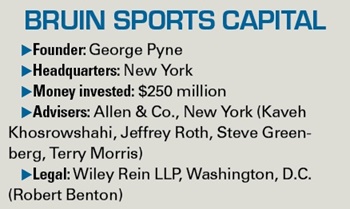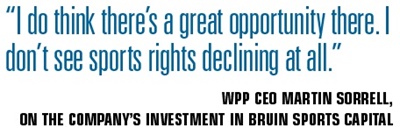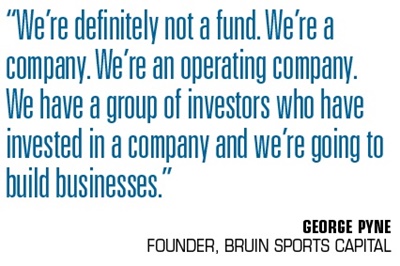George Pyne unfolded his 6-foot-5 frame from the dinner table after a night of explaining how his new sports venture would work. Following healthy stints at IMG and NASCAR, and at 49 years old, Pyne figures he’s got one more good run in him with Bruin Sports Capital, the business he raised $250 million to get started and hopes to run for the next 10 to 15 years.
“This is my shot,” he said as he departed the dinner meeting.
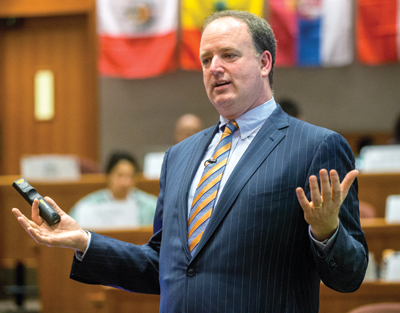 |
George Pyne estimates he had 100 meetings with investors and potential investors.
Photo by: GETTY IMAGES
|
Bruin will be his legacy.
Pyne announced the formation of Bruin Sports Capital last week, but the much talked about company had been in the works for at least the last six months. From last June, when Pyne hired Allen & Co. to help him find investors, he was set on creating a sports-focused business that might follow the model Peter Chernin established when Rupert Murdoch’s longtime No. 2 left News Corp. in 2009 to start The Chernin Group.
As Pyne worked with Allen & Co. to raise money from both domestic and international investors, he kept several principles in mind. Primary among them: It’s not just how much money you raise, but who are the investors, how flexible are they on terms, and do they have access to additional capital if needed.
And like Chernin, who spent 13 years at News Corp. before building his own powerful media and entertainment enterprise, Pyne is an operator, not a financial guru or an investor.
“I’m not placing bets on the Kentucky Derby,” Pyne said. “I’m the jockey on the horse.”
While Pyne and Allen & Co. made it look easy to raise $250 million in a startling six months, a glimpse behind the scenes revealed the emotional ebbs and flows as Pyne won some battles and lost others. The former football player at Brown University — hence the name Bruin, the school’s one-time nickname — estimated that he had 100 meetings with investors and potential investors all over the world since last June. Most of those were with high-wealth individuals or families who are active in the investment space.
WPP, the U.K. advertising and marketing giant, is the lead investor. CEO Martin Sorrell said his company invested 35 percent to 40 percent of the $250 million, or about $90 million to $100 million. Investments from individuals and families accounted for the rest.
Allen & Co.’s role was to set up the meetings with the people they’ve done business with before. Four executives from the established firm — Kaveh Khosrowshahi, Jeffrey Roth, Steve Greenberg and Terry Morris — were key to the process of identifying investment candidates and establishing the framework for Bruin. In fact, Khosrowshahi, a friend of five years, was the one who originally suggested this business plan to Pyne.
Pyne’s role was to sell them on his experience, his vision for what Bruin can be and the power of sports. Some of the potential investors were more knowledgeable about sports business than others.
“I’d be hard-pressed to find another example of an individual in this space who has raised this kind of capital,” said Greenberg, Allen & Co.’s managing director since 2002. “You might find examples like this in the tech space, where somebody built a better mousetrap, but it’s almost unprecedented in sports. It really says a lot about George.”
Pyne, whose agreement with the investors prohibits him from disclosing their identity, typically would meet with members of the groups or families looking to invest, as well as their advisers. In the process, Pyne said he traveled all over the U.S., Europe and the Middle East, and met with some of the wealthiest people in the world. And unlike investments through private equity firms, which seek to build companies and sell them in a quick three to five years, Pyne sought longer terms, in the 10- to 15-year range, so he can spend more time building the businesses.
“For many successful families, transactions can cause additional tax complications for them,” Pyne said. “The horizon for them is much longer. Many of them say, ‘If a company is so successful, why do we want to sell it?’ I found that to be attractive.”
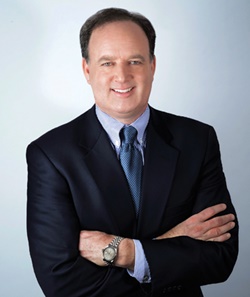 |
Pyne’s plan is to hold companies longer than private equity firms.
Photo by: CHRISTOPHE TEDJASUKMANA
|
Most of Pyne’s meetings lasted two hours or more. Some were in front of one or two principals, others were in front of entire families plus their counsel. Pyne presented to as many as 14 people at a time in one group.
One investor was convinced in a single meeting. Other investors required five or six follow-ups.
“Everyone is different,” Pyne said. “You’d go through ideas, concepts, and there’d be questions. There typically was a lot of back and forth on the concept, which was fine. I like a good debate. The more I did it, the better I got.”
In at least three cases, several promising meetings led to a dead end when potential investors withdrew, pulling huge sums off the table.
Toughest of all, Pyne said, was agreeing to a set of terms that would work across the eight to 10 different entities who were investing. The language in the contract and the terms had to be the same for each of them.
“You never truly have a commitment because you have to get all of the investors to agree to the same thing,” Pyne said. “It’s fluid. It’s like quicksand.”
Throughout December, Pyne said deals would fall apart when he thought they were done. What he had hoped to wrap up before Christmas dragged through the holidays until Bruin ultimately was able to announce the $250 million investment on Jan. 6.
“They all have to agree on every word,” Pyne said of the investors. “These are very sophisticated people who are highly successful negotiating these contracts, so it’s not easy.”
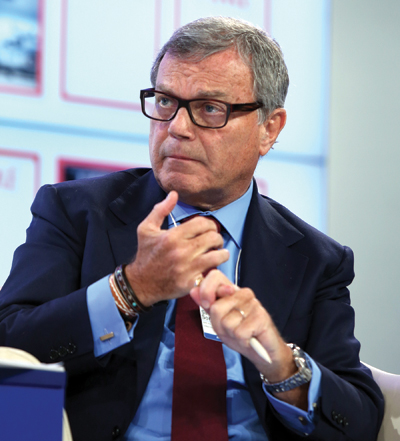 |
Photo by: GETTY IMAGES
|
Pyne repeatedly pointed to WPP’s reach and lines of business as appealing, and said he intends to keep Sorrell heavily involved as Bruin evaluates potential acquisitions. Pyne and Sorrell did not previously know each other. Sorrell built WPP largely by aggregating complementary businesses in the sector and it now employs 162,000 people across 110 countries. Among WPP’s many businesses are Kantar Media, GroupM Entertainment, Ogilvy and Chime Communications, which bought motorsports agency JMI in 2013.
“We’re pretty discreet about who we take on because we don’t like to be unsuccessful,” Allen & Co.’s Greenberg said.
“But for WPP and others to have this level of confidence in George and to raise this kind of capital, whether it’s in six months or six years, really validates everything we believed.”
In last week’s announcement, Sorrell said part of WPP’s motivation is to provide its global client base with business interests in sports media and sponsorship through Bruin. WPP was interested in IMG when it was for sale in 2013 — it was subsequently bought for $2.4 billion by WME — but Sorrell called it too expensive at the time.
“It’s not something we do a lot,” Sorrell of the investment in an interview with SportsBusiness Journal. “This is the first of its nature, in sports. We’ll be involved in the decision-making, but George is running it. … I do think there’s a great opportunity there. I don’t see sports rights declining at all.”
Now that Pyne has secured the $250 million in the first round of fundraising, he’s got to figure out how to spend it. “Now comes the hard part,” Sorrell said.
With $250 million in hand, Pyne said Bruin could go on to borrow up to $1 billion more, but he considers himself more conservative than that. Bruin likely will look to borrow against that initial $250 million with $250 million more, giving the firm at least $500 million of total buying power to make acquisitions.
But to be clear, Pyne said, Bruin is a company, not an investment fund. Bruin will look to acquire and operate businesses over a longer period than a private equity firm would. “We’re definitely not a fund,” he said. “We’re a company. We’re an operating company. We have a group of investors who have invested in a company and we’re going to build businesses.”
Pyne targeted $500 million because that should enable Bruin to buy multiple companies whose combined earnings before interest, taxes, depreciation and amortization will total $50 million to $75 million. That combined EBITDA likely will come from acquiring two, three, four or more companies.
Bruin will be focused on what Pyne called “platform businesses,” or companies that are complementary, not unlike the college business he helped build at IMG. Pyne started by buying Collegiate Licensing Co. in 2007 and built from there, acquiring Host Communications and ISP Sports. Later, IMG added smaller but complementary businesses like ticketing and seating.
“When I went to IMG [in 2006], I didn’t say right away, ‘Hey, let’s do college,’” Pyne said. “We went out for a year and studied the market. I want to apply that same discipline and rigor here to see what is available and what can be done over time and what has great growth potential.”
Pyne identified four categories on which Bruin will focus: sports and entertainment, media, marketing and branded lifestyle. Bruin will not go into talent representation, he said.
And while he doesn’t want to give away his pursuits, he said he’ll build a diversified portfolio. Industry speculation has ranged from motorsports — Pyne spent 11 years at NASCAR and still has deep roots in the space — to various forms of sports marketing agencies.
Just as when Pyne left IMG last summer, shortly after the company had been acquired by WME, he reiterated that he won’t try to compete directly with IMG. It’s possible, however, their paths will cross in the pursuit of new business.
“I love IMG and I have the utmost respect for Ari and Patrick,” Pyne said of WME-IMG co-CEOs Ari Emanuel and Patrick Whitesell. “They’re not going to lose any sleep over what we’re doing.”
As much as the last six months have been a whirlwind for Pyne, the pace isn’t likely to slow in 2015. He expects to hire at least three analysts and a staff of eight to 10. He’s also working to lock down office space for Bruin in the New York City area.
And he’s already evaluating potential acquisitions.
“The next 10 to 15 years will be about building a long-standing platform, a legacy that, for me, is personal,” he said.



